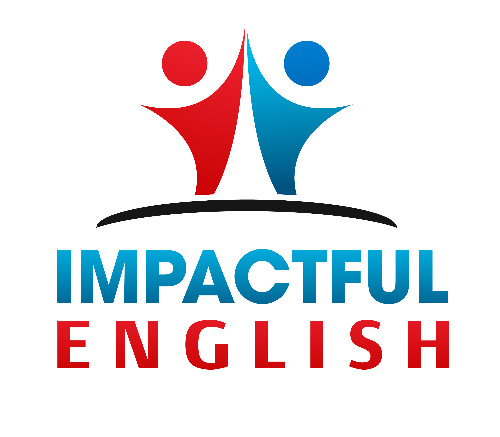

52 Phrases for Better Flowing English Presentations
/ Steven Hobson / Business English , English Presentations , Vocabulary

Do you give English presentations at work, but feel that you could communicate your message in a more objective, fluid way?
Maybe you have an English presentation coming up and want to make sure that your speech is clear and structured so that your audience doesn’t lose concentration and stays with you all the way to the end.
A technique that can help you achieve objective, clear, and structured English presentations, is to use linking phrases that join the separate parts of your presentation together.
English presentations normally consist of an introduction, the main body, individual parts of the main body, and the ending or conclusion.
To help maintain your audience’s attention, you need to signal when you are going from one part to another.
In this article, I teach you 52 phrases that do exactly this – linking the different parts together, and therefore, making your presentation flow better. You’ll find that these phrases will act as ‘signposts’ for the audience when you finish one part and start another.
52 Phrases to Improve the Flow of Your English Presentations
The introduction.
All good presentations start with a strong introduction.
There are a number of different ways you can begin your English presentation. Here’s a simple, but effective introduction structure which works for most types of business presentations:
Introduce – Introduce yourself and greet your audience. Introduce the presentation topic – Explain the reasons for listening. Outline – Describe the main parts of the presentation. Question policy – Make it clear to your audience when they can ask questions: during or at the end?
Here are some phrases which you can use to structure the introduction in this way:
1. Good morning/afternoon (everyone) (ladies and gentlemen). 2. It’s a pleasure to welcome (the President) here. 3. I’m … (the Director of …)
Introduce the presentation topic
4. By the end of the talk/presentation/session, you’ll know how to… / …you will have learned about… / 5. I plan to say a few words about… 6. I’m going to talk about… 7. The subject of my talk is…
8. My talk will be in (three parts). 9. In the first part… 10. Then in the second part… 11. Finally, I’ll go on to talk about…
Question Policy
12. Please interrupt if you have any questions. 13. After my talk, there will be time for a discussion and any questions.

Main Body
Now that you have finished the introduction, we now need to transition to the main body, and its individual parts in a smooth way.
There are three parts of the main body of a presentation where linking phrases can be used:
Beginning the Main Body Ending Parts within the Main Body Beginning a New Part
Here are some phrases which you can use for these parts:
Beginning the Main Body
14. Now let’s move to / turn to the first part of my talk which is about… 15. So, first… 16. To begin with…
Ending Parts within the Main Body
17. That completes/concludes… 18. That’s all (I want to say for now) on… 19. Ok, I’ve explained how…
Beginning a New Part
20. Let’s move to (the next part which is)… 21. So now we come to the next point, which is… 22. Now I want to describe… 23. Let’s turn to the next issue… 24. I’d now like to change direction and talk about…
Listing and Sequencing
If you need to talk about goals, challenges, and strategies in your English presentation, listing phrases can help link these together and improve the flow of your speech. If you have to explain processes, sequencing phrases are helpful:
25. There are three things to consider. First… Second… Third… 26. There are two kinds of… The first is… The second is… 27. We can see four advantages and two disadvantages. First, advantages… 28. One is… Another is… A third advantage is… Finally…
29. There are (four) different stages to the process. 30. First / then / next / after that / then (x) / after x there’s y. 31. There are two steps involved. The first step is… The second step is… 32. There are four stages to the project. 33. At the beginning, later, then, finally… 34. I’ll describe the development of the idea. First the background, then the present situation, and then the prospect for the future.
After you have presented the main body of your English presentation, you will want to end it smoothly.
Here are typical sections transitioning from the main body to the ending of the presentation, and then inviting the audience to ask questions:
Ending the Main Body Beginning the Summary and/or Conclusion Concluding An Ending Phrase Inviting Questions and/or Introducing Discussion Thanking the Audience
Ending the Main Body
35. Okay, that ends (the third part of) my talk. 36. That’s all I want to say for now on (the 2017 results).
Beginning the Summary and/or Conclusion
37. To sum up… 38. Ok, in brief, there are several advantages and disadvantages. 39. To conclude… 40. I’d like to end by emphasizing the main points. 41. I’d like to end with a summary of the main points.
42. I think we have seen that we should… 43. In my opinion, we should… 44. I recommend/suggest that we… 45. There are three reasons why I recommend this. First, … / Second, … / Finally,…
An Ending Phrase
46. Well, I’ve covered the points that I needed to present today. 47. That sums up (my description of the new model). 48. That concludes my talk for today.
Inviting Questions and/or Introducing Discussion
49. Now we have (half an hour) for questions and discussion. 50. So, now I’d be very interested to hear your comments.
Thanking the Audience
51. I’d like to thank you for listening to my presentation. 52. Thank you for listening / your attention. / Many thanks for coming.
Linking phrases are like the skeleton which holds your presentation together.
Not only do they improve the flow and help guide the audience, but by memorizing them they can also help you remember the general structure of your presentation, giving you increased confidence.
To help you memorize, I recommend saying the linking phrases on their own from the beginning to the end of your presentation while you practice.
I also suggest memorizing the introduction word for word. By doing this, you will get off to a great start, which will settle your nerves and transmit a positive first impression.

Author: Steven Hobson
Steven is a business English coach, a certified life coach, writer, and entrepreneur. He helps international professionals build confidence and improve fluency speaking English in a business environment.
Related posts

Never Stay ‘Blocked’ during a Meeting in English Again

A Proven Way to Negotiate More Confidently in English

You Don’t Need Perfect English to Speak with Confidence
Useful English phrases for a presentation

Presentations have the advantage that many standard phrases can be used at various points. Perhaps you wish to welcome the audience, introduce the speaker and the topic, outline the structure, offer a summary, or deal with questions. In all these situations, you can apply a number of useful expressions that will make your presentation a linguistic success.
At the beginning of each presentation, you should welcome your audience. Depending on who you are addressing, you should extend a more or less formal welcome.
Good morning/afternoon/evening, ladies and gentlemen/everyone.
On behalf of “Company X”, allow me to extend a warm welcome to you.
Hi, everyone. Welcome to “Name of the event”.
Introducing the speaker
The level of formality of your welcome address will also apply to how you introduce yourself. Customize it to match your audience.
Let me briefly introduce myself. My name is “John Miller” and I am delighted to be here today to talk to you about…
First, let me introduce myself. My name is “John Miller” and I am the “Position” of “Company X”.
I’m “John” from “Company Y” and today I’d like to talk to you about…
Introducing the topic
After the welcome address and the introduction of the speaker comes the presentation of the topic. Here are some useful introductory phrases.
Today I am here to talk to you about…
What I am going to talk about today is…
I would like to take this opportunity to talk to you about…
I am delighted to be here today to tell you about…
I want to make you a short presentation about…
I’d like to give you a brief breakdown of…
Explanation of goals
It is always recommended to present the goals of your presentation at the beginning. This will help the audience to understand your objectives.
The purpose of this presentation is…
My objective today is…
After presenting the topic and your objectives, give your listeners an overview of the presentation’s structure. Your audience will then know what to expect in detail.
My talk/presentation is divided into “x” parts.
I’ll start with…/First, I will talk about…/I’ll begin with…
…then I will look at…
and finally…
Starting point
After all this preparation, you can finally get started with the main part of the presentation. The following phrases will help you with that.
Let me start with some general information on…
Let me begin by explaining why/how…
I’d like to give you some background information about…
Before I start, does anyone know…
As you are all aware…
I think everybody has heard about…, but hardly anyone knows a lot about it.
End of a section
If you have completed a chapter or section of your presentation, inform your audience, so that they do not lose their train of thought.
That’s all I have to say about…
We’ve looked at…
So much for…
Interim conclusion
Drawing interim conclusions is of utmost importance in a presentation, particularly at the end of a chapter or section. Without interim conclusions, your audience will quickly forget everything you may have said earlier.
Let’s summarize briefly what we have looked at.
Here is a quick recap of the main points of this section.
I’d like to recap the main points.
Well, that’s about it for this part. We’ve covered…
Use one of the following phrases to move on from one chapter to the next.
I’d now like to move on to the next part…
This leads me to my next point, which is…
Turning our attention now to…
Let’s now turn to…
Frequently, you have to give examples in a presentation. The following phrases are useful in that respect.
For example,…
A good example of this is…
As an illustration,…
To give you an example,…
To illustrate this point…
In a presentation, you may often need to provide more details regarding a certain issue. These expressions will help you to do so.
I’d like to expand on this aspect/problem/point.
Let me elaborate further on…
If you want to link to another point in your presentation, the following phrases may come in handy.
As I said at the beginning,…
This relates to what I was saying earlier…
Let me go back to what I said earlier about…
This ties in with…
Reference to the starting point
In longer presentations, you run the risk that after a while the audience may forget your original topic and objective. Therefore, it makes sense to refer to the starting point from time to time.
I hope that you are a little clearer on how we can…
To return to the original question, we can…
Just to round the talk off, I want to go back to the beginning when I…
I hope that my presentation today will help with what I said at the beginning…
Reference to sources
In a presentation, you frequently have to refer to external sources, such as studies and surveys. Here are some useful phrases for marking these references.
Based on our findings,…
According to our study,…
Our data shows/indicates…
Graphs and images
Presentations are usually full of graphs and images. Use the following phrases to give your audience an understanding of your visuals.
Let me use a graphic to explain this.
I’d like to illustrate this point by showing you…
Let the pictures speak for themselves.
I think the graph perfectly shows how/that…
If you look at this table/bar chart/flow chart/line chart/graph, you can see that…
To ensure that your presentation does not sound monotonous, from time to time you should emphasize certain points. Here are some suggestions.
It should be emphasized that…
I would like to draw your attention to this point…
Another significant point is that…
The significance of this is…
This is important because…
We have to remember that…
At times it might happen that you expressed yourself unclearly and your audience did not understand your point. In such a case, you should paraphrase your argument using simpler language.
In other words,…
To put it more simply,…
What I mean to say is…
So, what I’m saying is….
To put it in another way….
Questions during the presentation
Questions are an integral part of a presentation. These phrases allow you to respond to questions during a presentation.
Does anyone have any questions or comments?
I am happy to answer your questions now.
Please feel free to interrupt me if you have questions.
If you have any questions, please don’t hesitate to ask.
Please stop me if you have any questions.
Do you have any questions before I move on?
If there are no further questions at this point, I’d like to…
Questions at the end of a presentation
To ensure that a presentation is not disrupted by questions, it is advisable to answer questions at the very end. Inform your audience about this by using these phrases.
There will be time for questions at the end of the presentation.
I’ll gladly answer any of your questions at the end.
I’d be grateful if you could ask your questions after the presentation.
After answering a question from the audience, check that the addressee has understood your answer and is satisfied with it.
Does this answer your question?
Did I make myself clear?
I hope this explains the situation for you.
Unknown answer
Occasionally, it may happen that you do not have an answer to a question. That is not necessarily a bad thing. Simply use one of the following phrases to address the fact.
That’s an interesting question. I don’t actually know off the top of my head, but I’ll try to get back to you later with an answer.
I’m afraid I’m unable to answer that at the moment. Perhaps, I can get back to you later.
Good question. I really don’t know! What do you think?
That’s a very good question. However, I don’t have any figures on that, so I can’t give you an accurate answer.
Unfortunately, I’m not the best person to answer that.
Summary and conclusion
At the end of the presentation, you should summarize the important facts once again.
I’d like to conclude by…
In conclusion, let me sum up my main points.
Weighing the pros and cons, I come to the conclusion that…
That brings me to the end of my presentation. Thank you for listening/your attention.
Thank you all for listening. It was a pleasure being here today.
Well, that’s it from me. Thanks very much.
That brings me to the end of my presentation. Thanks for your attention.
Handing over
If you are not the only speaker, you can hand over to somebody else by using one of these phrases.
Now I will pass you over to my colleague ‘Jerry’.
‘Jerry’, the floor is yours.
We hope that our article will help you in preparing and holding your next presentation. It goes without saying that our list is just a small extract from the huge world of expressions and phrases. As always, the Internet is an inexhaustible source of further information. Here are the links to two websites that we would recommend to you in this context.
usingenglish
- What is the difference between American English (AE) and British English (BE)?
Comments are closed.
image sources
- : © Thaut Images
Fast and affordable
Choose the number of words: ?
How many days do we have?
Get to know us first! We can correct a random page from your document completely free of charge and with no obligation from your side.
- Interesting
- Miscellaneous

37 Useful Phrases For Presentations In English
- Post author: Harry
- Post last modified: 07/02/2024
- Post category: Business English Vocabulary
- Reading time: 10 mins read
Here you will learn at least 37 useful phrases for presentations in English. Improve your business English skills and feel confident when making presentations in English.
Presentation phrases for setting the scene, recapping, ending a presentation in English and more.
Listen to the podcast Speak Better English with Harry or watch it on YouTube at Learn English with Harry .
List of phrases for presentations in English
useful phrases for presentations in English
Hi there, this is teacher Harry, and welcome back to my English lessons where I try to help you to get a better understanding of the English language.
Okay, so what are we going to cover in the lesson today? Well, all of us, myself included, have to make presentations, from time to time to staff or to bosses, or to clients or customers, whoever it may be. And if you’re using English, not as your native language, then it can be a bit of a challenge. You might feel lacking in confidence. You might feel that you’re not up to the other guys.
But you can do it.
So I’m going to give you some useful phrases that you can use in relation to presentations.
give a gift of learning Offer up to 50% off
Great way to improve your English. Use code LOVE24

setting the scene
You might just simply say at the presentation particularly if it’s online,
- It’s good to see you all here.
- It’s great that you could join me.
- I’m very pleased to be here.
- I’m very pleased to be talking to you today.
- I’m very pleased to be presenting to you today.
- I’m glad you could all make it.
- Thank you all for coming.
- Thank you all for joining in.
- Thank you all for coming together on Zoom.
Whatever it might be, you can adjust the words to suit the media and the medium by which you’re presenting to your guests. Staff, colleagues, clients.
common phrases for starting off presentations
And then if we talk about other useful expressions and phrases.
It’s a good idea to spend 30 seconds introducing yourself.
So my name is Harry, I work in this department, I’d like to talk to you today about…
- The topic of my presentation today is….
- I’m planning to tell you about today….
- I’d like to introduce you to….
So in those sorts of expressions, you’re setting the scene again, you’re telling them exactly what you’re going to cover. And that’s a really good idea in a presentation because then everybody knows what’s going to be spoken about.
My name is Harry, I work in the marketing department. My presentation today is about a new product. The presentation is probably going to take about 20 minutes. And if you have any questions, then please ask them as we go through the presentation.
book your trial English Lesson
Introducing a talk.
Now, if you want to introduce the talk, you could say:
- What I’d like to do in this presentation is…
- First of all, I’ll give you a brief overview of…
A brief overview of the product, a brief overview of the background, a brief overview of our plans.
- Okay, then I’ll talk about….
- And after that, I’d like to show you some market research.
- After that, I’d like to show you our projections.
- After that, I’d like to show you this specific plan for the launching of this product.
So you go step by step by step.
referring to visuals
So in any presentation, visuals are really important, and they can help you.
And they can also support you if you’re a little bit lacking in confidence about the presentation itself.
And you perhaps don’t want to be the focus of everything.
So the type of phrases you might use in that context would be something like:
- You will notice on this chart…
- If you look at this slide, we can see…
- Have a look at these figures…
As I said, it helps you, it supports you and enables you to just sort of hide a little bit behind those slides that focus on the screen, not specifically on you.
Useful Phrases For Presentations In English
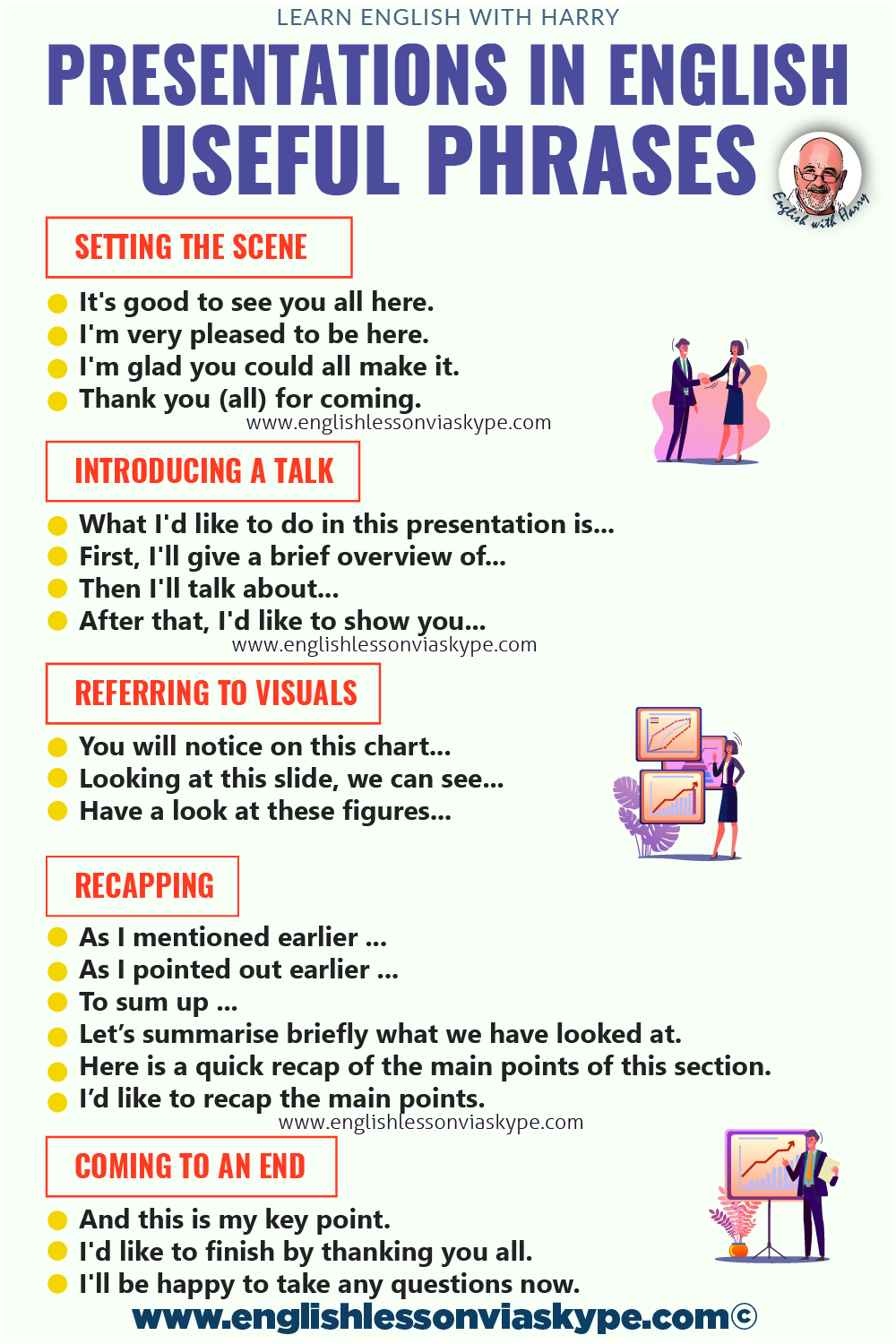
Share and help other students to improve English language skills.
Finishing off a section.
And when you want to finish off in relation to those sort of aspects, you might just summarise by saying,
- Well, that’s all I wanted to say on that particular topic.
- If you’ve got any questions, I’d be happy to take them now.
- To summarise what I said is…
- If you want to contact me offline, just send me an email.
- As I promised, I’ve now finished the presentation, it only took 20 minutes.
- I appreciate you watching and listening and your attention.
- If I have any questions, I’ll be happy to answer them now.
- Have you any questions?
So again, helpful information directly in them, how they can get in touch with you after your presentation.
speak better English podcast - episode 368
Checking and moving on.
So during the presentation, we want to make sure that the people are listening, but you also don’t want to spend too much time on each particular point.
So you check their understanding so far, and then you move on. So you might say to the people,
- Does that sound okay to you?
- Do you follow that?
- Is it clear?
- Can I clarify anything else?
- If not, let’s move on.
- Let’s look at the next slide.
- Now, let’s move on to the really important topic of…
- Let’s turn to the topic of budgets.
So you pinpoint exactly what you want to cover. When you’re going to cover it and then you move on. So you check that they understand it.
I also find in these types of presentations, particularly if they’re a bit longer than a few short slides, that it’s a good idea to do some recapping.
To recap means to go over what you’ve done before. Not a huge amount of detail because you don’t want to bore them by going through everything, but you recap quite quickly.
- Before I move on…
- I’m going to recap quickly…
- Let me summarise briefly…
- Here’s a quick recap of what we’ve covered today.
- I’d like to recap the main points.
- Let me go over the main points for you once more.
All of those good, acceptable expressions and words that you can use.
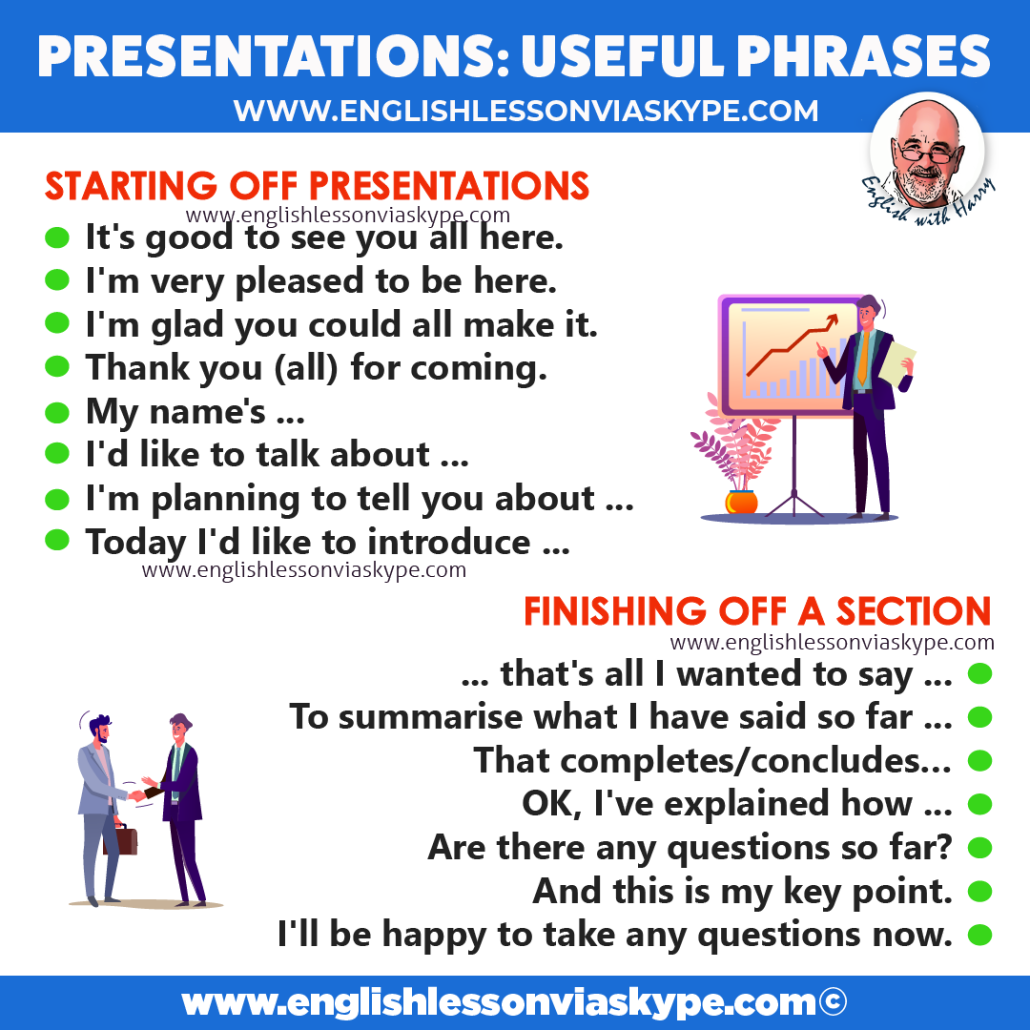
coming to an end
And then when you come to the end of the presentation, you want to sign off, you want to finish them. We can say,
- Well, this is my key point.
- This is the key point in all of this, so let me finish on this.
- This is what I want to say to sum up in a few words.
- I’d like to finish now by thanking you all for your kind attention.
- I look forward to joining you again soon.
- I look forward to any questions.
- I look forward to receiving your emails.
- I’d be happy to take any questions now.
All nice and polite ways of informing people that this is the end.
So there’s somebody out there in the audience who’s asleep, they’ll probably wake up at that point when you say and finally or, in conclusion
Well, hopefully you’ve got something in particular that you can hold onto there. Something that can help you if you’re making presentations in English.
If you have any other queries, come to me, I’m very, very happy to help you. My contact details are www.englishlessonviaskype.com .
And indeed, if you want some help, how to make presentations, if you want some help, how to get through interviews, or you just want general help with your English well, why not try our one-to-one online English lessons .
Thanks for listening. Join me again soon.
More information
For more information on English grammar rules, English collocations and English idioms, check out the links below:
How to learn English vocabulary easily
English idioms about holidays and travel
You can always study English advanced level at Learning English with the BBC and British Council Learn English .
You will love these English lessons

A visit to the Pub – English traditions
A visit to the Pub is a very English or indeed Irish, Scottish and Welsh thing to do!! A Pub

English Vocabulary related to Problems and Advice
Here you will learn useful English vocabulary phrases related to problems and advice. Unsure what to say when someone’s facing
enrol in a free course

- Phrasal Verbs + Grammar + Funny English Idioms
online english courses from €7.99
- free english mini course
- english grammar refresher
- 73 most common mistakes
- Advanced english workout 1
- advanced english workout 2
- advanced english workout 3
- job interview in english
- how to teach english online
follow me on social media
Advanced english learning course.
Improve English from intermediate to advanced level in my intensive English course.
55 online lessons + 6 online courses + direct contact with Harry
learn english with us
- zoom/skype english lessons prices
- our teachers
- english learning blog
- Odnoklassniki icon Odnoklassniki
- Facebook Messenger
- LiveJournal
How can I advance my English?

60 Useful and Impactful Phrases for Presentations in English: A Quick Glimpse for Presenters
Introduction.
Are you up for a presentation in English but don’t know how to start yet? Preparing and making a persuasive presentation in English is quite challenging and taxing. You have to consider a lot of things before you can finalize it. A good presentation relies heavily on the words or phrases you use to clearly convey your message to your target audience.
Then, what kind of phrases for presentations in English should you use to persuade your audience and get them involved in your presentation?
In this article, we are going to talk about useful and impactful phrases for presentations in English that you can effectively use in your future presentations. Before that, let us discuss first the importance of these phrases in English presentations.
The Importance of Having Impactful Phrases for Presentations in English
In the business world, presentations play a significant role because they make reports easier to convey and understand. Presentations delivered in English are impactful and are often commended. Thus, having impactful phrases for presentations in English is an additional advantage to get your audience’s attention and be on track.
Say for example you are assigned to lead a new project and you are tasked to give a progress report to your boss. It would not be nice to give him just verbal updates about the progress of the project you handle. It would be better to show him the things that have been working well so far, and things that have been a worry. With just a verbal report, your boss might not be able to understand clearly.
With that, using a presentation is important for him to clearly visualize what is going on with the project. Presentations also give you the chance to be constructively corrected. It also serves as a formal report.
Using impactful phrases for presentations in English leaves a lasting impression on your audience. These phrases can greatly enhance the effectiveness of your report. The more you use persuading phrases or expressions in your presentations, the greater the chance you have to be recognized.
Do you want to be recognized and commended? This article is for you, so keep reading and we’re with you all throughout.
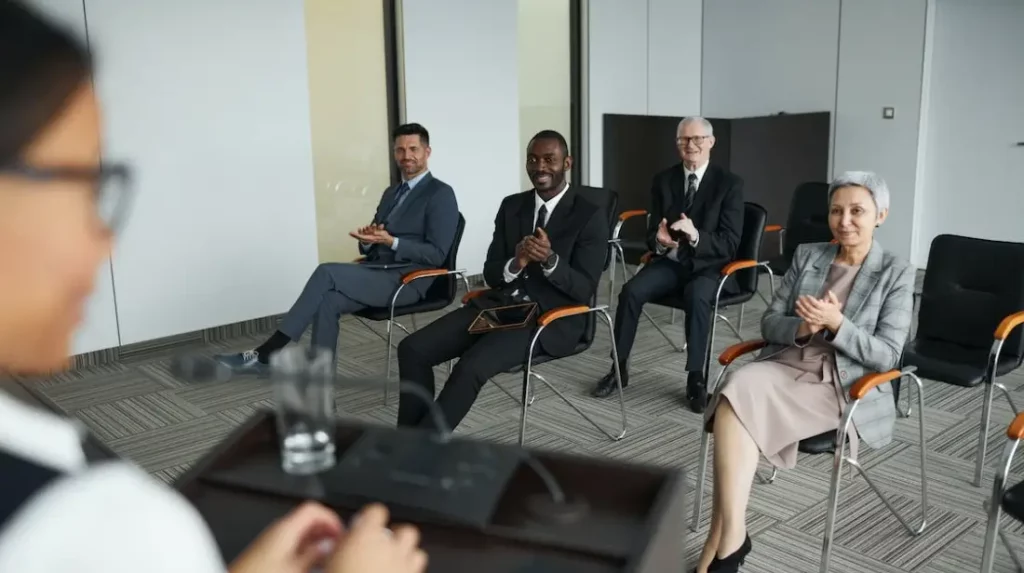
Useful and Impactful Phrases for Presentations in English
Aim for a long-lasting impression on your audience by using the following useful and impactful phrases in your next presentation in English.
- Setting a bright atmosphere
At the beginning of the presentation, you would want your audience to interact with you throughout so setting a warm and bright atmosphere before it is crucial. You can use the following expressions:
- “Good day, everyone! Who’s up for a game?”
- “It’s nice to see everyone with a smile today.”
- “I am glad you all came to attend this meeting.”
- “Before we start, let’s have an icebreaker first to keep everyone going!”
- “Have you ever…?”
Remember to get your audience engaged right at the beginning of your presentation.
- Setting your audience’s expectations
In some presentations, the audience expects more of what you can give, so it is good to give them a brief overview of what the presentation is about and what will happen.
- “This presentation will last about 30 minutes.”
- “All questions and concerns will be attended to after the presentation.”
- “We will allocate spare time for your questions and concerns.”
- “The first part of the presentation would be…”
- “There will be more slides in the presentation so please bear with me.”
- “This presentation will take longer than usual.”
- “If you have questions during the presentation, please write them on these pieces of paper so we can answer them later.”
- “Please take down notes for your reference.”
- “Handouts will be distributed to everyone.”
- “There will be more games and interaction in this presentation.”
- Starting your presentation
It is always nice to warmly welcome your audience before going deeply into your topic.
- “I would like to formally welcome everyone today.”
- “Please sit comfortably and relax.”
- “Let’s start this presentation by introducing myself. My name is _________.”
- “My name is ______ and I am from _______ department.”
- “I’d like to share a quote from …”
- “I have an anecdote to share and I’d love everyone to listen.”
- “What do you think about the quote shared by…?”
Sometimes, it is better to start your presentation with an anecdote or a quote related to your presentation.
- Introducing your topic
You may use the following phrases for presentations in English when introducing your topic.
- “Today, I will be talking about…”
- “The topic of my presentation today is about …”
- “My presentation is relevant to…”
- “I am glad to present to you the progress of …”
- “As you can see, I am here to report about…”
- “There are three major topics that I’m going to discuss today.”
- Discussing the content of your topic: showing images, graphs, and illustrations
When discussing the content of your presentation, it is good to use the following expressions.
- “As you can see in the graph…”
- “Here is an example illustration of…”
- “Look at the graphic on the screen.”
- “This illustration/graph shows the result of…”
- “Things don’t look good in this image so…”
- “I visualize this project as…”
- “You can see the graph showing the trends…”
- Engaging your audience
It’s okay to pause for a while and get your audience involved in your presentation.
- “What do you think about it?”
- “Do you have any additional insights?”
- “Please feel free to share your thoughts about it.”
- “Your opinion really matters.”
- “Kindly let me know if you have questions or clarifications.”
- “I’d love to hear your thoughts about this.”
- “Who would like to share their personal thoughts on this?”
- Emphasizing or highlighting important information
- “This is very important because…”
- “The good thing about this one is that…”
- “Our key takeaway for this matter is…”
- “The most important thing in this project is the…”
- “The decrease will not affect our sales target…”
- Entertaining questions and concerns
Some members of the audience inevitably ask you questions about your presentation so it is best to be prepared. If not, might as well be polite instead.
- “Thank you for your question, Mr./Ms. _____.”
- “That’s a very good question.”
- “Thank you for raising that concern.”
- “I’d love to answer your question, but let me finish this first.”
- “I will attend to all your questions after the presentation.”
- Ending your presentation and leaving a long-lasting impression
You may not impress all in the audience with your presentation but you must know how well you delivered your presentation. End it with a bang, and leave a lasting impression on your audience.
- “This is not easy, but I know we can do this.”
- “Thank you so much for sparing your precious time on this presentation.”
- “I really appreciate your presence in this meeting.”
- “We are all in this together, so let’s start making a difference.”
- “I’d like to commend our workers for…”
- “Good job to everyone for a job well done.”
- “Kudos! Let’s continue to be productive and excellent.”
- “You’re all amazing.”
You can also end your presentation with a quote or a personal anecdote for your audience to remember you.
These phrases for presentations in English are helpful ways to make your presentation easy to understand as well as impactful. These are just examples of phrases you can use when presenting in English. You can always experiment and create sounding phrases to persuade your audience.
By knowing these phrases, you enhance the effectiveness of your delivery as well as your communication skills. This is your way to overcome your fear of speaking English . Most importantly, the impression you will leave to your listeners will last for a long time.
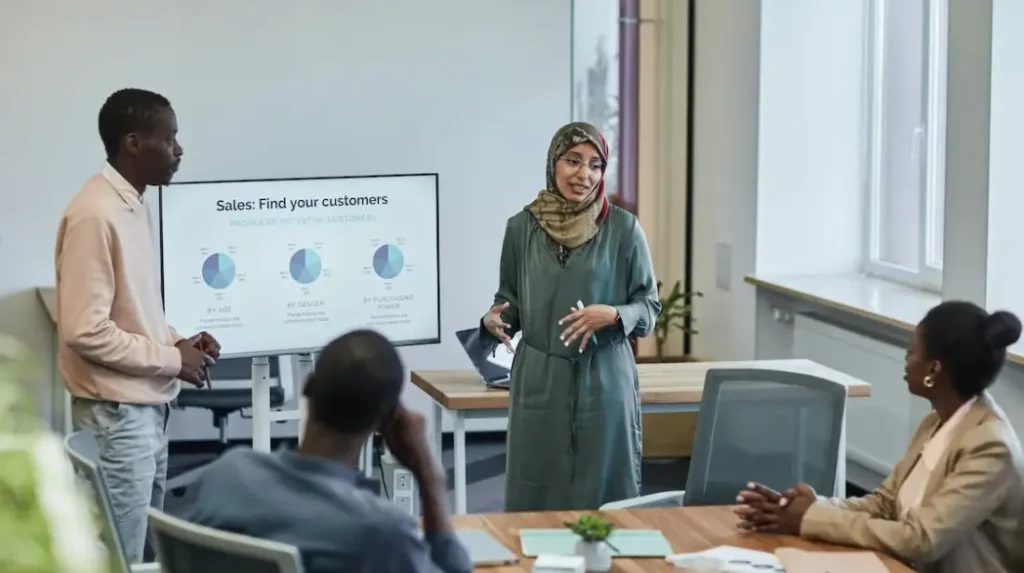
What to consider when preparing a presentation?
Presentations can be simple depending on your target audience, the context, and the time frame. These are just a few of the things you have to consider when preparing a presentation. You can also ask yourself the following questions.
- Know your target audience. Who are the attendees? Your presentation must be appropriate for the listeners.
- Where is the presentation? Check the situation.
- How long will the meeting last? How much time is allocated for your presentation?
- What data should you present? Think about the most important highlight in your topic.
- Should you use a PowerPoint presentation? This is better than just speaking without material.
- Are games or activities suitable for the presentation? If not, never mind. You’ll just waste your time.
- What interactive activities should you include? This is nice to get your audience engaged.
- What if you cannot answer the questions? Anticipate and prepare a backup answer.
Presentations are always easy when you know how to consider things during your preparation. Things do not always go easy, especially when it is your first time. However, just be confident and relax. Your goal is to deliver a good and effective presentation, but most of all, to impress your audience.
Get ready for your next presentation…
You have just learned some useful and impactful phrases for presentations in English. Now you are ready for your next presentation. Focus and think about your primary goal: the impression.
- March 12, 2024
Leave a Comment Cancel Reply
Your email address will not be published. Required fields are marked *
Save my name, email, and website in this browser for the next time I comment.
You may enjoy these articles

Skyrise 4, 7th Floor, Cebu City, 6000, Cebu
+63 32 479 9047

Start typing and press enter to search
Blog > English Presentation Structure (Introduction, Closing) & useful Phrases
English Presentation Structure (Introduction, Closing) & useful Phrases
02.21.20 • #powerpoint #presentation #english.
When giving a presentation in english, there are certain guidelines you should follow. Maybe you haven't got a lot of experience presenting - or you would simply like to refresh your already existing knowledge - we're here to teach you the basics about presenting and provide you with a free list of useful phrases and the basic structure you can in your presentation!

1. Structure
The general structure of a presentation is the following:
- Introduction
It is up to you to design these three parts. Using videos or everyday-examples can be a great way to introduce the audience to the topic. The important thing is that you capture the audience's attention from the beginning by making an interesting introduction. The main part is where you present your topic, ideally divided into sections. You can be creative with it - incorporate images, videos, stories or interactive polls . We generally recommend using different kinds of elements, as that makes the presentation more lively. Make sure your main part is well structured, so your audience can follow. In the conclusion, you should give a short summary of the points you made without adding any new information. You can also make an appeal to your audience in the end.
2. Useful Phrases
Here you'll find several phrases that you'll need in every presentation. Of course, you should adapt them and use them in a context that is suitable for your setting. The phrases are divided into subcategories so you can find what you're looking for more easily.

Starting your Presentation
In your introduction, you should:
Welcome your audience
Good morning/afternoon/evening everyone!
Ladies and gentlemen, I welcome you to my presentation about...
Introduce yourself
I am ... (from company ...) and today I would like to introduce you to the topic of ...
My name is ... and I am going to talk about ... today.
Icebreakers (for audience engagement)
Icebreaker polls are an amazing way to engage your audience instantly. They function as a fun and playful element at the beginning, giving you the perfect start you need to give a successful presentation. Click here to read our detailed post about icebreaker polls!
Mention the presentation topic and the reason for giving the presentation
I am grateful to be here today and tell you you about...
I would like to take this opportunity to talk about ...
I am here today to talk to you about ...
The reason why I am here today to talk about ... is ...
The purpose of this presentation is to ...
My goal today is to ...
Hopefully, by the end of the presentation, you will all know more about ...
Give a short overview of the content
To make it as understandable as possible, I divided my presentation into ... parts. In the first part, I will concentrate on ..., the second part will be about ..., ...
First of all, I will give you a short introduction, then we will move on to ...
... and finally, I will give you some insights to ...

Here are a few phrases that you could use during the whole presentation, but especially in the main part.
Engage your audience
In order to raise the audience's attention and improve their engagement, it is extremely important to make contact with them. A great way to do so is by adding interactive elements such as polls. If you would like to know more about this topic, read our article on How To Boost Audience Engagement . You can also use a software like SlideLizard , which allows you to conduct live polls, do Q&A sessions with your audience, share your resources and many more benefits that take your presentation to the next level.
Please raise your hand if you ...
Have you ever thought about ... ?
I would like to do a poll about ...
Please ask any questions as soon as they arrive.
On one hand, … on the other hand…
Comparing … with …, we can see that…
Clearly, … makes more sense than …
Whereas Option A is …, Option B is …
Making new points
Firstly,… Secondly,…
What also has to be mentioned is…
Next, I would like to bring up the topic of…
That being said, now we are going to take a look at…
Let's move on to the next topic.
On the next slide,…
The last thing I would like to mention is…

We made a whole blog post about how to pose questions in your presentation: The Right Way to do a Question Slide .
Talking about images or videos
In this image you can clearly see that ...
We are now going to take a look at a picture/video of ...
I'm going to show you a video by ... about ... now.
I've prepared a video about ...
Talking about statistics and charts
I am now addressing this graph that refers to the results of study XY.
In the graph on this slide, you can see that ...
The average is at ...
This graph clearly shows that the majority ...
According to this graph, the focus should be on ...
What that study tells us for practice is that we should ...
Emphasizing
I would like to emphasize the importance of ...
Moreover, it has to be said that ...
I want to stress the importance of ...
We always have to remember that ...
This is of high significance because ...
That part is especially important because ...
When something goes wrong
I am sorry, but it seems like the projector isn't working.
Could someone please help me with ...?
Is anybody here who knows how to ...?
Could someone give me a hand with ...
I would like to apologize for ...
I apologize for the technical problems, we are going to continue in a minute.
I am sorry for the inconvenience.
End of Presentation
In the conclusion, you should...
Sum up the main points
In conclusion I can say that…
To sum up the main points,…
With all mentioned aspects taken into consideration, I can say that…
Make an appeal
So please, in the future, try to be conscious about...
Please take a moment to think about...
I would like to encourage you to...
Thank your audience and say goodbye
It was a pleasure being here today.
Thank you for listening and goodbye.
Thank you for being such a great, engaged audience. Goodbye.
Thank you so much for listening, see you next time.
What is the structure of a presentation?
Your presentations should always have an Introduction, a Main part and a Conclusion.
What is a good way to begin a presentation?
You can start by introducing yourself, giving an overview of your topic, telling a little story or showing the audience an introductory video or image.
What are good phrases to use in English presentations?
There are many phrases that will make your presentation a lot more professional. Our blog post gives you a detailed overview.
Related articles
About the author.

Pia Lehner-Mittermaier
Pia works in Marketing as a graphic designer and writer at SlideLizard. She uses her vivid imagination and creativity to produce good content.
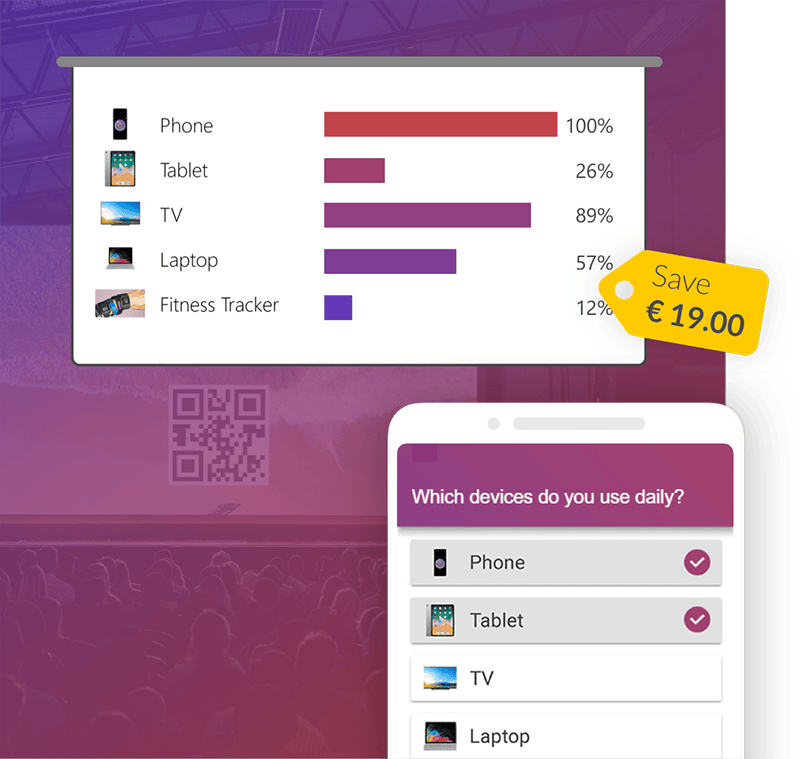

Get 1 Month for free!
Do you want to make your presentations more interactive.
With SlideLizard you can engage your audience with live polls, questions and feedback . Directly within your PowerPoint Presentation. Learn more

Top blog articles More posts

How To Make an interactive Quiz in PowerPoint - Tutorial

All about notes in PowerPoint Presentations
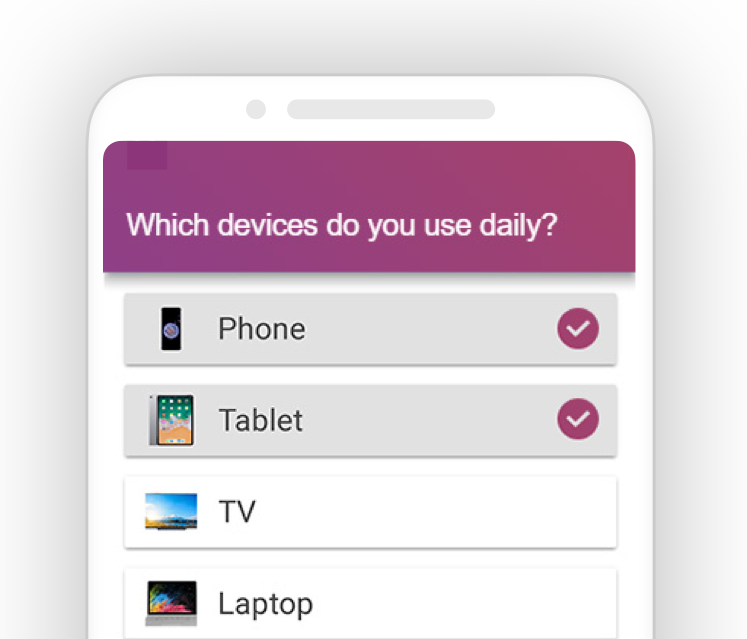
Get started with Live Polls, Q&A and slides
for your PowerPoint Presentations
The big SlideLizard presentation glossary
Visual communication.
If there are used images or videos for communication, it is visual communication. Visual Communication is almost used everywhere like on television, posts on social media (Instagram, Facebook), advertisement.
To interview somebody means to ask a person different questions. An interview is often done by journalists.
Effect Options
In the effect options in PowerPoint, further details can be specified for the selected effect.
Horizontal Communication
Horizontal communication is the exchange of information between people, departments or units within the same level of an organisational hierarchy of a company.
Be the first to know!
The latest SlideLizard news, articles, and resources, sent straight to your inbox.
- or follow us on -
We use cookies to personalize content and analyze traffic to our website. You can choose to accept only cookies that are necessary for the website to function or to also allow tracking cookies. For more information, please see our privacy policy .
Cookie Settings
Necessary cookies are required for the proper functioning of the website. These cookies ensure basic functionalities and security features of the website.
Analytical cookies are used to understand how visitors interact with the website. These cookies help provide information about the number of visitors, etc.
You are using an outdated browser. Please upgrade your browser or activate Google Chrome Frame to improve your experience.
35 Powerful Presentation Phrases in English for Engaging Your Audience

Your palms are sweating.
For a moment, your mind goes blank.
All eyes are on you.
That moment right before you start presenting – as you take in your audience – is usually the scariest. The nervousness lessens with practice, but even the most frequent public speakers still get butterflies in their stomach sometimes. Whether you’re facing an entire room of people or looking at everyone through your laptop screen, giving a presentation can still be intimidating – or exciting, once you move beyond the fear.
There’s an extra layer of challenge too if you have to speak in your non-native language. For a more professional-sounding and engaging presentation, we’ve compiled some of the most useful English presentation phrases below.
We’ll also explore what else you can do to make even more of an impact on your audience. With the right intonation, body language, and gestures, you’ll really be able to catch their attention and emphasize your points.
Delivering a Powerful Presentation
To lay the groundwork for your presentation in English, here’s what you’ll have to do first:
Consider the audience
You’re probably always going to need slides, but every presentation will be different – and the audience that you’ll be presenting to won’t always find the same points interesting. Because of this, you’ll have to tailor your message to them. What style of presentation would be a good fit? For example, some audiences would want to see a lot of number-crunching, while others might be looking for more personal storytelling .
Prepare a structure
Structure is key in presentations. People have short attention spans, and they can be forgetful. At the end of the day, your goal is for them to remember at least the main points in your presentation. What message do you want to convey? Since you might be discussing a lot of information, you can make it more digestible by ensuring that there’s a logical progression and then ending with a summary.
Key Business Phrases
Once you’ve decided on the style and message of your presentation, you can take it up a notch by including certain English presentation phrases all throughout. Let’s break it down from start to finish:
Introduction
This is when you’ll be warming up your audience before you proceed to your main points.
Greeting the audience
If you’re presenting to people who aren’t too familiar with you, you can quickly introduce yourself and mention your role or company.
- Good morning, everyone. I’m glad to be able to present to all of you.
- Hello, everyone! It’s nice to see all of you today. I’m [name], the [position] from [company].
Describing your topic
After greeting the audience, you’ll be explaining to them what your presentation is all about. To set their expectations, you might show them an outline of the talk and mention if there’ll be any activities such as breakout discussions.
- I’ll be talking about…
- I’ll be talking about our financial metrics over the past year.
- The topic of this presentation will be…
- The topic of this presentation will be major trends in the logistics industry.
- I’ll be discussing first the [first topic], next [second topic], and finally [third topic].
- I’ll be discussing first the project’s ideation process, next our initial trial, and finally, presenting our results.
Addressing questions and technical concerns
People might be wondering if they can ask questions during your presentation, so you can clarify this at the start. If you’re providing handouts or presenting online, it’s useful to ask people to alert you about any technical concerns.
- Please feel free to ask any questions during the talk.
- For questions, there will be a Q&A section at the end.
- Can all of you see and hear me properly? Please let me know if you have any technical difficulties during the presentation.
The body will make up the bulk of your presentation. Ideally, you would go through each of your points logically while letting your audience know when you’re moving on to the next section.
The longer your presentation, the more important it is to use sequencing phrases. These act as cues that let your audience know where you are in the presentation. You can think of these as similar to detour signals that make the audience much more likely to get your meaning.
- First, let’s discuss the…
- First, let’s discuss the initial spark for this idea.
- Moving into [the next item / point] …
- Moving into item 4, we can see that this is a major pain point for our target market.
- This leads us to the next…
- This leads us to the next section, where we’ll be looking at the facts and figures.
Linking is closely related to sequencing. Similar to writing, you can have a smoother presentation by connecting your ideas rather than suddenly jumping from one point to another. You can also refer back to points that you’ve mentioned before to make your presentation more cohesive.
- In connection to what I said earlier…
- In connection to what I said earlier about growing our online presence, we can now look into potential social media campaigns.
- What this means is…
- What this means is that most of our growth is coming from a certain sector. Let’s analyze the data for this in the next section.
- This ties in with…
- This ties in with our survey findings about user reactions. I’ll go into detail about changes we’ve made to the app as a result.
Giving examples
To fully convey your point, you can bring up specific examples and case studies. These are much more memorable as well as engaging because you can tell these in the form of a story.
- For example…
- For example, costs were reduced significantly when we switched to the following materials.
- To demonstrate this point…
- To demonstrate this point, I’ll be showing you a video of a business that used this problem-solving method.
- Here’s an example of…
- Here’s an example of a seasonal product that our customers loved.
Showing visuals
Visuals naturally attract people’s attention. If you’re using slides for your presentation, take the opportunity to include images, diagrams, infographics, or even charts.
- As you can see from this…
- As you can see from this photo, we’ve redesigned our office space.
- Here’s a diagram / picture / chart that shows…
- Here’s a diagram that shows a high percentage of people are comfortable with online shopping.
- If you look at this…
- If you look at this infographic, you can see that the new color palette comes off as fun and casual.
Citing data
Citing data from research makes your presentation more persuasive. When you’re talking about results that you’ve achieved, try to bring up actual numbers – this can go a long way towards impressing your audience.
- According to this study…
- According to this study from [journal], 65% of eCommerce companies are looking for more efficient payment methods.
- Based on our research…
- Based on our research, the most enthusiastic buyers of wellness products in this city are in the 20 to 30 age range.
- Looking at the data…
- Looking at the data, you’ll notice that there’s been an 18% spike in sales since we migrated our platform.
Restating an idea
Sometimes you’ll want to restate an idea so it’s easier to understand. This also serves to emphasize it. Because of the repetition, people are more likely to remember it compared to if you’d only mentioned it once.
- In other words…
- In other words, partnering up with this client can make our operations more efficient and seamless.
- Another way of saying this is…
- Another way of saying this is that there might actually be more demand than supply by next year.
- What I mean is…
- What I mean is we’re already more than halfway to our business objective.
Handling technical issues
When you’re presenting on video call, all kinds of glitches can happen. Someone might have connection issues, you might have to figure out an app feature you’ve never used before, or background noises might keep interrupting your call. The phrases below can be very handy in these kinds of situations.
- If you can’t hear me, can you type in the chat, please?
- Could everyone mute their mic? There’s a lot of background noise.
- Sorry. The call dropped. I’m back through.
Concluding the Presentation
By this time, the hardest part is already over! Still, you’ll have to wrap up your presentation nicely by going over the key takeaways during the conclusion. Your audience might also have questions that they’ll want you to address.
Summarizing the presentation
Out of everything that you’ve discussed, what would you like people to get out of it? A short summary towards the end serves to highlight your main ideas.
- To wrap up…
- To wrap up, I’d like to point out three major takeaways.
- As a summary…
- As a summary of this report update, I would say we have seen a positive uptick in our workflow and productivity.
- All in all…
- All in all, we believe we’ve seen good results for this stage of our progress.
Thanking the audience
Similar to your greeting at the start, it’s common to address your audience again towards the end by thanking them for their time.
- Thank you for listening!
- Thank you to everyone for being here.
- I’d like to thank you all for coming here.
Addressing questions
If you’re open to questions from your audience, you can have a short question-and-answer session after your presentation.
- Do you have any questions or clarifications?
- Feel free to ask me about any of the points I made during the presentation.
- Let me know if you have any questions.
Practice is Crucial
When you’re all set with the content of your presentation, the next step is to practice your delivery. Regardless of how well you know the topic of your presentation, practicing it at least once will help you be more confident. You’ll discover potential issues that you can fix too before you go live.
Do a run-through
The most basic way to practice is to do a run-through of your entire presentation . Set a timer on your phone, open up your slides, then start talking – all while imagining that you’re already presenting to your audience. Since you’re acting as if it’s in real-time, this means avoiding any pauses where you have to look up information.
A run-through can pinpoint any weaknesses in your presentation, and you’ll notice any parts where you might be uncomfortable talking. You’ll also be able to see how much time you’ve spent so you can pace yourself accordingly.
Record yourself
A more intensive version of the run-through basic would be to record yourself presenting. You can either record your voice or take a full video of yourself. People often notice that they use filler words a lot such as “um” or “uh.” You’ll also be able to check your pronunciation and whether you sound confident and natural all throughout.
Since body language can make or break your delivery, watching a video of yourself presenting is an incredibly effective way to improve your performance. Do your facial expressions match what you’re saying? Are you maintaining good posture throughout and making efforts to connect with the audience?
Presenting on Video Call
Technical issues happen often enough in face-to-face presentations, but they’re even more frequent during video calls. To avoid any awkward delays when you’re presenting, get comfortable with the platform that you’ll be using.
If it’s a face-to-face presentation, double-check your slides and make sure any images or videos are showing properly. For video calls, try doing a test call on the app or even call up a friend to practice. You can also get familiar with the app’s basic features, such as screen-sharing or inviting people to breakout rooms.
Let’s explore some of the most common glitches (and how you can deal with them gracefully!):
Situation 1: You’re having a hard time hearing other people because of their laggy connection.
For a presentation to work, everyone needs to have a decent internet connection. If someone’s connection drops, they won’t be able to see or hear you properly, and you won’t understand what they’re trying to say, either. In this case, let them know right away that you can’t hear them. You can also ask them to talk to you over chat instead.
Example Phrases:
- [Name], you’re cutting in and out. Would you mind reconnecting?
- Audio problems – can you type it on chat instead?
Situation 2: You get disconnected from the call.
In the case that it’s your connection that’s faulty, you might have to disconnect then reconnect your call. This can be awkward because it interrupts the flow of your presentation. Alerting your audience using certain English phrases can reassure them while getting you back on track with what you were saying.
- Sorry, guys, dropped call. But I’m back.
- Connection problems, everyone. Gonna log out and back in.
Situation 3: People are having a hard time figuring out how to turn on their audio or video.
Another reason why you’d want to be really familiar with the video platform is you might have to coach people when they experience glitches. It’s almost expected that a few people might accidentally forget to turn on their mic while speaking. Alternatively, they might have issues with turning on their camera.
- I can’t see you, [name]. [Give instructions on how to turn on their video.]
- I can’t see you, Fatima. Look for the camera icon and make sure there’s no red line through it.
- Typing in chat: “Make sure your mic’s unmuted.” [Clarify how they’ll know if they’re unmuted.]
- Typing in chat: “ Make sure your mic’s unmuted. There should be no red lines through it.
The best presentations excel in all three areas: content, structure, and delivery.
Including some of the key English phrases above will upgrade your performance. Aside from setting a professional tone, these English presentation phrases set the pace for your audience so they’re aware of where you are in the discussion. Your message will sound clearer, and your audience will be able to follow your ideas better.
The basic rules for presentations are the same, whether you’re on a video call or stepping in front of a stage. With the tips above, you’re all set to prepare an amazing presentation in English.
Related posts:

11 Essential English Gestures You Should Know to Advance Your Career

The Ultimate Guide to Mastering Greetings and Small Talk in English
Reply to this review cancel.
Thanks for choosing to leave a comment. Please keep in mind that all comments are moderated according to our comment policy , and your email address will NOT be published. Please Do NOT use keywords in the name field. Let's have a personal and meaningful conversation.
Recent Articles

The 30 Best Intermediate English Courses for B1, B2 and Beyond

The 1028 Most Common Words in English

Restaurant Conversations: 7 Scenarios When You Eat in an English-Speaking Place
Enter your e-mail address to get your free pdf.
We hate SPAM and promise to keep your email address safe

101 Must-Know Transition Phrases for Engaging Presentations Online

Giving presentations is often feared by many professionals, but if the presentation is online and you’re not a native speaker, things get even trickier. One tip to make things easier? Learn useful phrases to help you navigate your presentation. In this article, you will find lots of helpful resources to give remarkable presentations . Listen to the episode above, download the checklist below, and learn some of the phrases we present. If we missed any, tell us in the comments below.
General vocabulary for presentations
Sometimes, the smallest changes in your presentations can make the biggest differences. One of them is to learn a few phrases that give you confidence during your speech. Here are some important verbs to get you started:
To highlight
To emphasize
To walk you through (*very common in business presentations!)
To send around
To carry on (similar to continue)
To get carried away
To sum up (similar to summarize )
To focus on
Vocabulary to start your presentation
Learn how to powerfully start your presentation with these 4 simple steps. Here’s some vocabulary you can use:
Welcome your audience
Good morning/afternoon/evening everyone. Thank you for joining us today, and welcome to today’s webinar.
Hello everyone, I’m very happy to be speaking with you today.
Introduce yourself
My name is Susan, and I’m part of the design team here at Globex Corporation.
First of all, a little bit about my background – I am the Team Lead at [Company], and I’ve been in charge of [your main responsibility] for [X] years.
I’d like to tell you a bit about myself – my name is Eve I’m the Operations Manager here at [Company].
Introduce the topic and goal of the presentation
Today, I’d like to talk about…
This presentation will take about [X] minutes, and we will discuss…
We’ve allocated [X] minutes to this presentation. and I’ll talk about…
I’d like to give you a brief breakdown of…
I’d like to take this opportunity to talk about…
The main goal of this presentation is…
The purpose of this presentation is…
My objective today is…
Read these 5 tricks the best public speakers use to captivate their audience .
Addressing questions from the audience
If you have any questions about anything, feel free to interrupt.
If anything isn’t clear, please click on the ‘raise hand’ button and I’ll do my best to answer your question.
I’d be happy to answer your questions at the end of the presentation.
If you have any questions, please kindly wait until the end to ask them. We will have [X] minutes for a Q&A session at the end.
Since today’s audience is considerably large, we will not have time for questions, but please email me at [email protected]
Learning new English words is not easy, but you can achieve effective communication through practice and repetition. If you are a Talaera student, visit the Library to practice your vocabulary for presentations. If are not part of the Talaera community yet, learn how we can help you here .
Clear out technical issues
Can everyone hear me well? Let me know if you encounter any technical difficulties throughout the presentation.
If you are not speaking, please put yourselves on mute.
If you feel that the sound quality is poor throughout the presentation, please let me know.
Transition to the main topic of the presentation
Hi everyone, I think we might still be missing a few people but I’m going to kick things off now so we have time to get through everything.
All right, let’s dive right in!
All right, let’s jump right in!
Let’s get started.
Let’s kick things off.
I’m going to talk about
The purpose/subject of this presentation is
I’ve divided the presentation into 3 parts: In the first part, … / Then in the second part, … / Finally, I’ll go on to talk about…
Let me begin by looking at…
Let me start with some general information on…
Vocabulary for the main body of your presentation
Introduce a topic or section.
Now let’s move to the first part of the presentation,
We can see 4 advantages and two disadvantages. First,
On the one hand… On the other hand…
There are two steps involved. The first step is… The second step is…
There are four stages to the project.
Request more info about our English training
Transition to a new section
All right, let’s turn to…
Now we come to the next point, which is
Okay so that’s [topic 1], but what about [topic 2]?
There’s a lot more to talk about, but since we’re pushed for time , let’s move on to [topic 2].
This leads me to my next point, which is…
Give examples and details
For example…
A good example of this is…
To illustrate this point…
This reminds me of…
To give you an example…
Let me elaborate further on…
Describe visual aids
As you can see [from this infographic]
This chart shows
If you look at this graph, you will see
From this chart, we can understand how
Let me show you this [image, graph, diagram]
On the right/left
In the middle of
At the top/bottom of the picture
Emphasize an idea
This is important because
I’d like to emphasize that
We have to remember that
Repeat the same message with different words
In other words
To put it more simply
So, what I’m saying is that
Let me say that again.
It’s easy to get stuck in the middle of a presentation, especially if English is not your mother tongue. Here are +21 Top Tips You Need To Know if you’re learning business English .
Finish your presentation and summarize
The end of a presentation, together with the opening, is one of the most important parts of your speech. Read these 5 effective strategies to close your presentation and use the vocabulary below.
That’s all I want to say for now about [topic].
To sum up, …
This sums up [topic].
So in a nutshell, …
So to recap, …
In brief, …
To conclude, …
I’d like to conclude by emphasizing the main points…
That’s it on [topic] for today. In short, we’ve covered…
So, now I’d be very interested to hear your comments.
And this brings us to the end of this presentation. I hope [topic] is a little clear after today.
So to draw all that together, …
Start and navigate the Q&A session
Thank you for your attention. I hope you found this presentation useful, and I’d be happy to answer any questions.
Thank you for listening. We now have [X] minutes left. Do you have any questions?
Thank you for your question, [Name].
I’m glad you asked.
That’s an interesting question.
That’s a great question, I must say. I’m not 100% sure, but off the top of my head, I can tell you that…
Are you asking about [topic 1] or [topic 2]?
Can you please clarify what exactly you mean by [question]? I’m not sure I fully understand.
I’m afraid I don’t have the exact figures at hand, but if you give me your email address at the end, I can follow up with you later.
Does that answer your question?
I hope that makes sense. Is that the kind of answer you were looking for?
Take your presentation skills to the next level.
Start Talaera’s online course on impactful presentations for free and take your skills to the next level. Explore all our resources on public speaking skills in English .

Keep reading about presentation skills:
21 Helpful Tips For Remarkable and Outstanding Presentation Skills
How To Start a Presentation: Follow These 4 Easy Steps
How To Bring Across Your Main Idea In A Presentation Effectively
5 Effective Strategies To End A Presentation
6 Public Speaking Tricks To Captivate Your Audience
How To Do Effective Business Storytelling According To Former Prosecutor
8 Little Changes That’ll Make A Big Difference With Your Presentations
3 Quick Public Speaking Tips For Your Next Presentation
Your Body Language May Shape Who You Are [TED Talk Lesson]
Talaera Talks – Transcript Episode 5
Topic : Deliver impactful presentations
Listen : Spotify , Apple Podcasts , Google Podcasts
Duration : 22 min.
Intro Welcome to Talaera Talks , the business English communication podcast for non-native professionals. My name is Paola and I am co-hosting this show with Simon. In this podcast, we’re going to be covering communication advice and tips to help express yourself with confidence in English in professional settings. So we hope you enjoy the show!
Okay, welcome back for our third episode of Talaera Talks. This is Simon, and I’m joined with Paola. Paola, how are you doing?
0:37 Hi, Simon. I’m great. Happy to do another episode.
0:41 Yeah, absolutely. And Happy Friday.
0:44 Happy Friday!
0:49 So today, our topic: Presenting in English. I’d like to start this episode with a quote I found on Harvard Business Review that I thought was really interesting. It says, “Even native English speakers often anticipate disaster when making presentations. By but for non-native speakers, the anticipatory and situational anxiety associated with their unique challenges (these challenges – being understandable, choosing the right words, speaking spontaneously), can be overwhelming. Moreover, if these concerns interfere with your willingness or ability to make business presentations, the impact can be career-limiting.” So yeah, that’s a pretty kind of heavy quote to start. But it is something that we see from a lot of our clients, right?
1:52 Yeah, it’s super interesting. It was super interesting to read. It’s something we know, but it’s important to remind it that it is presentations, the topic we have today is something that is not pleasurable for anyone, not for non-native speakers, but also for native speakers. So that’s something to point out. And today, we talked about that… We said that we wanted to start with those challenges or fears that we see from our clients, our learners.
2:25 Yeah, and it’s usually around the same things, you know, we, at least for me, I come into contact with so many of these, so many of our students who are so competent in their, in their daily lives, what they’re doing in their professional lives. And they come to me with these with these fears, like this just general lack of confidence, or imposter syndrome, right? This I don’t know if I really deserve to be speaking and, you know, kind of explaining this concept to all these people.
3:05 Mm-hmm. Yes. And also the fear of not being understood, well, they know what I’m saying, well, they understand my accent. There’s a lot of worries and concern around accent and our pronunciation expert, Lisa hosted a webinar, actually last week, where she explained that accent matters. But as long as people understand you, it’s fine. You don’t need to be perfect. Everyone has an accent. So that’s also totally fine.
3:37 And this being Yeah, this being one of I think, at least for me, in my experience, one of the most frequently asked for aspects from students. So you know, and just to like, again, just say that this is a challenge for everyone, not just, you know, non-native English speakers. You know, I think all of us have a tough experience or somebody that we think of when we think about public speaking, it’s, it’s like this, yeah, really anxiety-riddled thing. I mean, I don’t have any, you know, funny personal stories, but uh, do you, Paola?
4:20 You want me to tell my embarrassing story, don’t you?
4:22 Please, you must.
4:25 So I used to teach at a university in Vietnam when I lived there, and the classes where it rains, you know, from perhaps 50 students to up to what 300 there’s was a class with, you know, 2-300 students and there was a little stage it wasn’t too high, but there was a little stage and I fell off.
4:46 You fell off the stage. This was during or after the presentation, or…?
4:56 It was around the beginning of the presentation. So…
5:01 During! Oh, I thought it was it was like after like you were walking off?
5:06 No, I move a lot. I use my body language quite a lot. And that was one of the moments where I overdid it, probably, and fell off.
5:17 Wow. Well, I’m glad that you’re still here with us.
5:21 Yeah, you know, but that’s the story that I sometimes not always tell it. But I sometimes tell it when my students say, Oh, I’m nervous, and I assume that it can happen, you know, I thought it was going to be a disaster. And then I actually ended up making friends with the students that turned out okay.
5:39 Right. Well, yeah, I mean, today, we’re not necessarily going to go into the physical dimensions of how to avoid falling off the stage. But we do have some, some good tips, right?
5:54 Yes. And to provide some advice on how to deliver presentations, and lose that fear, we’ve divided it into three main blocks. And those are what to do before the presentation, tips for during the presentation. And then even after there’s things you can do to, to get better.
6:18 Right, let’s start with the first, right, what can we do before the presentation in terms of getting ready, preparing?
6:30 So preparing, it’s a very general term, but one of the tips that we like to give is, think of the WHAT, WHY and NEXT. So WHAT is your presentation about? WHY should they listen to you and not look it up online (or listen to a podcast, like ours)? And in what NEXT means – what is supposed to happen next? Do they need to do anything, go on a website, send you feedback? Are you going to send them the materials? So what why our next is so straightforward and simple. But when I asked this question to our clients that are so thrown off, and they don’t know what to answer sometimes,
7:10 Yeah, I think that’s one of those things. And I struggle with this all the time is, when I get an idea or something like that. It’s so easy to just jump over those most basic things of, you know, what, why and index, those are so, so basic, but it’s such it’s, they’re so foundational, right? And in terms of creating something that people will understand and be able to, to really attach to.
7:41 Yep. And do you have any tips around how much you should learn? Should you write the whole thing? Or should you memorize?
7:52 Yeah, that, you know, this is a good question as well, that a lot of our learners ask in terms of, yeah, you know, I’m just going to go and write it all out. And then I’ll have an idea. And I’ll feel better because I can write it and change it so that it sounds more professional. It sounds like I know what I’m talking about. And I always tell people, please don’t try to prepare a presentation where you’re reading a script, it is just the most unnatural thing ever. And, and it, you won’t end up sounding more professional, if anything, your audience is going to detach, because they’re going to sense that something’s not really right here, it doesn’t seem genuine, right doesn’t seem real, it just seems like this person is doing what he’s doing, which is reading off of a script. And even still a lot of times with a lot of our learners where they know that, okay, I know this material. But I’m going to put all of my effort into making this perfect slide this perfect presentation. So I would say, focus on actually knowing the material itself really well. More than focusing on how the presentation looks, you know, these kinds of things. Because once you’re in that situation where you’re on the stage, and people are looking at you, at least you’ll be able to Windows like kind of red Sirens of you know, panic and anxiety show up. You’ll have learned the material itself so well that you can roll with that.
9:29 Yes. And you also have room for improvisation because your brain is so used to the content and you know, so well what you want to say that that’s when your brain starts to come up with anecdotes and that’s the fun thing that gets you hooked. And that’s the main Why should people listen to you instead of reading an article online?
9:49 Exactly. Because for most of our students, you know what you’re talking about. That’s why you’re up there. That’s why you have the opportunities to speak there is because someone thinks you’re qualified enough to speak to all these people. So trust in that and go with that. So yeah, so we have right not, not over learning. Don’t script it right? What else can we do?
10:14 Practice, practice, practice, practice, practice in your mind, but more importantly verbalize it, say it out loud. And recording yourself is uncomfortable for everyone. But it works. I have never tried it. I always told my students should record yourself, you should record yourself and they were like, Huh. And just a few of them did it. And when we started with the webinars, I haven’t done something like it before. And I said, Okay, I’ll use my own tip. And it was one I’m comfortable. And two, super helpful. So if you get to go over the sound of your own voice, I would say do it.
10:54 Yeah. You know, this is one thing that I have to be totally honest here. Doing these podcasts is the first time I’ve actually recorded myself for a long time. And I’ve learned a lot about, you know, not saying the word Absolutely. 500 times, yeah, within the span of 20 minutes. So those are good learning lessons. Definitely. Okay, and then so we have that. And then the last little tip is, I would say get an English mindset before 30 minutes to an hour before the presentation. And that could be listening to a podcast, you know, like Talaera Talks, or, you know, watching a show on Netflix that’s, that’s in English, whatever you can do to get your kind of English mind, you know, in the zone before you go up and actually speak English. So So those are all of our kind of pre presentation tips, what you can do before, so what about during,
11:58 so for during, there’s a lot of things that you can you can do to improve your presentations. But the first tip is to learn how to start to have a mind map of what am I going to do at the beginning. So you start confident already. So welcome, everyone, introduce the people introduce the topic and go to the main point, those four parts will help you have a nice start. Welcome, everyone. For example. Hi, everyone. Welcome to today’s presentation. Today, we’ll be talking about business events, introduce the people, you can introduce yourself , like, Hi, my name is Paula and I’m a business English instructor at Telstra, and perhaps even the audience. Today we have with us students from all different nationalities and levels, or, you know, whatever the audiences, that’s also helpful for everyone to understand, introduce the topic, or give you some best practices for business emails , and a few templates, and then go to the main point. So a simple sentence like Alright, let’s get down to business. So having those welcome introducing people introducing the topic and going to the main point will help you have a nice start.
13:16 Yeah, and I like that concept of that the mind map is so good. Because it’s it’s not the scripting, like we were talking about before, it’s having a kind of a little mental checklist. So that when those first few minutes, were you’re up there on the on stage, and you’re like, oh god, oh, god, here we go. Here we go. You have that little checklist that I created. Okay, so I welcomed introduced the people the topic, and now to the main point, and that can get you in the zone and going I really liked that. Yeah, so so having that, that starting template. And then another thing would be, I would say slowing down, slowing it down. And this is really I think it touches on a lot of aspects. The first would be just the general anxiety, we tend to speak a lot faster when we’re really anxious, you know, but by slowing down, it really helps with non native English speakers because it helps with the accent. And it helps with giving you some time to really think through your next thoughts. Now, I’m not saying that you should, while you’re speaking, try to think steps three, four or five ahead of you. But giving yourself a little bit of time to Okay, I’m going through this pattern now. Now I can go to the next one, right. And doing that, you know, another with the slowing down a tip if you’re really nervous to go in is prefacing your speech. So before you really get into everything, maybe after the welcome part is just to say, Hey, you know, I’m going to try to speak as clearly as possible, as English as myself. first language and really smile and maybe make a little joke about that. And I think that’s a good way to open it out for the audience to show some vulnerability and and help. I mean, what do you think about that?
15:13 Yeah, I mean, we see that with, sometimes with celebrities, when they’re not native speakers, and they admitted, and they, they kind of put yourself put themselves, as you said, in that vulnerable position, and that makes them even cuter.
15:28 Mm hmm.
15:29 So it’s making yourself human, I think it’s always a good tip. And you were saying that slowing down helps with your accent and also for yourself to gain time to really know what you’re going to say. But also for the for the audience. We don’t mind people making some little pulses, so that they also have time to collect their thoughts.
15:50 Right, right. Yeah. Yeah, definitely. Those are, those are two really good aspects, starting, you know, the template and then slowing down, right. Yeah, kind of diffusing the anxiety by saying, Hey, you know, this isn’t my first language. And that really gets the audience on your side, right. And then another would be not reading off of your slides. I mean, this is kind of the basic, you know, what you learn in school, but it’s also something that a lot of people get, yeah, get, get hooked on, just because it’s like a safety net. And I would say that’s where the overlearning the material that we talked about beforehand comes into play. Anything else in this?
16:42 Oh, recap for sure. After every section, do a little recap, and at the end to recap where you summarize the main points of the whole presentation?
16:54 Yeah, yeah. Good. Good. So So summarize. Yeah, yeah. And that’s a that’s a good, you know, I would say three aspects, four aspects that during the presentation, if you keep these in, in your mind, it’s, it’s, I would say, it’s going to help a lot. And so now we’re going to move to what can we do after the presentation? We’ve done it, we’ve walked off the stage. Whoo, I’m so glad that’s over. Now, is all of our work done? No.
17:27 No, not really. That’s now it’s your chance to actually learn from, from everything you did. So one of the tips we suggest is try to ask for feedback. But that’s not so easy, right, Simon?
17:42 Yeah, it’s, I think, a big question. And that is, who do you get the feedback from? Right?
17:50 So we, we would always suggest to try and find someone you can trust someone who is honest, and who can give you objective feedback. So in some cases, that can be your manager, but sometimes it’s a colleague that understands the topic, and can really provide some feedback on how you did.
18:13 Yeah. And that’s, I think, in terms of learning, this is one of the most crucial thing is reflecting back on what you did, and seeing what worked, what didn’t work, and how can I take that and move forward? Because especially with presenting, it’s a skill, and it takes practice, practice, practice. And, and I think, for a lot of people, you should jump at the chance to do this. So that you can continue to learn and continue to grow. But be sure to reflect by Yeah, by asking for feedback and seeing what worked,
18:47 for sure. And ideally, that would be someone, perhaps from work that can see how you did and like the actual show, if not Talaera teachers also do that. So you can present your own presentation, pretending it’s the actual one. And that’s how we can provide feedback on the structure, the vocabulary, the language in general.
19:08 Yeah, absolutely. I do that. Oh, there you go. Absolutely. Definitely. See, I’m reflecting back and learning as we go. I’m working. I’m learning that. Yeah. But I’ve done that recently with a couple of students where we’ve gone through their deck and looked at what are their plans in terms of presenting and we’ve kind of gone through in detail that together. So So yeah, so that was kind of I would say the biggest thing in terms of afterward.
19:40 So we have the pre-presentation, just as a quick recap for the pre-presentation and before your presentation, always remember the what why next, what is your presentation about? Why should people listen to you and what should happen next overnight Learn the content. be super confident about what you want to talk about. But don’t script it. Don’t write everything down. Otherwise, it would sound like you’re just reading.
20:11 Write and practice through verbalization. record yourself, even though it may be awkward, but it’s a great learning technique. And then get in that English mindset beforehand by Yeah, listening to a podcast or what have you. And then during the presentation, right, starting with the template, Paolo was discussing the welcome introducing the people the topic, and then going to the main point,
20:37 slowing down a little bit. It’s not necessary to go super fast. It’s not only not necessary, but people will understand you better if you take your time and make some pauses. Of course, don’t read off their slides. Tell them the story.
20:54 Right, right. And remember
20:56 to recap, just like we’re doing now. Send them or tell them a quick summary and the main points,
21:03 right, and don’t fall off the stage as well. That’s ideally we forgot. Ideally, it’s final for then, as the final point, right, asking for feedback, finding that person that can get you that feedback that’s so important to you. Finding what worked and moving forward.
21:21 That’s right. All right. Do we have it for today?
21:25 I think that is it for today. Yeah. I had a lot of Thanks. Yeah, I had a blast. And thanks for meeting up. And we have a lot of good stuff coming up with Talaera. Right.
21:38 We have webinars, our blog is busier than ever. So go on the http://blog.talaera.com/ , check out the resources. And what else?
21:51 Find us on LinkedIn. And yeah, please ask any questions, we’d be glad to get back to you. So that is it for today. And thank you to all of our listeners. So far, we’re excited to keep growing this. And as always, keep learning!
22:11 And that’s all we have for you today. We hope you enjoyed it, and remember to subscribe to Talaera Talks . We’ll be back soon with more! And visit our website at https://talaera.com for more valuable content on business English. You can also request a free consultation on the best ways for you and your team to improve your communication skills. So have a great day and keep learning!

- Talaera Talks Podcast
Related Posts
Unlock Career Growth: How Language Proficiency Transforms Your Future
How To Effectively Reduce Your Accent in English!
This Is Why Your Tone in English Matters in Customer Success

IMAGES
VIDEO
COMMENTS
Effective - successful in producing a desired or intended result. Springboard - springboard is also something that provides an opportunity to achieve something. Handout - a document given to students or reporters that contains information about a particular subject. Q&A - an abbreviation for 'question and answer'.
Learn how to use linking phrases to join the different parts of your presentation and make it clear and structured. Find 52 phrases for introduction, main body, ending, listing, sequencing, and more.
Here are some useful introductory phrases. Today I am here to talk to you about…. What I am going to talk about today is…. I would like to take this opportunity to talk to you about…. I am delighted to be here today to tell you about…. I want to make you a short presentation about…. I'd like to give you a brief breakdown of….
give a gift of learning Offer up to 50% off. setting the scene. common phrases for starting off presentations. book your trial English Lesson. introducing a talk. referring to visuals. finishing off a section. checking and moving on. recapping.
You may use the following phrases for presentations in English when introducing your topic. "Today, I will be talking about…". "The topic of my presentation today is about …". "My presentation is relevant to…". "I am glad to present to you the progress of …". "As you can see, I am here to report about…". "There ...
200+ must-know business presentation phrases in English Here is a list of natural-sounding English phrases that you might like to use in your next business presentation . These will give you some building blocks to structure your presentation around and add variety to your business English vocabulary .
The English phrases listed below are organised according to the following basic steps and will help you structure your presentation. Good morning, everyone. Hi! It's great to see so many familiar faces here today. Welcome to the audience Hello everyone, welcome to … Let me introduce myself. My name is … For those of you who don't know me,
The general structure of a presentation is the following: It is up to you to design these three parts. Using videos or everyday-examples can be a great way to introduce the audience to the topic. The important thing is that you capture the audience's attention from the beginning by making an interesting introduction.
The best presentations excel in all three areas: content, structure, and delivery. Including some of the key English phrases above will upgrade your performance. Aside from setting a professional tone, these English presentation phrases set the pace for your audience so they're aware of where you are in the discussion.
General vocabulary for presentations. Sometimes, the smallest changes in your presentations can make the biggest differences. One of them is to learn a few phrases that give you confidence during your speech. Here are some important verbs to get you started: To outline. To clarify. To highlight. To emphasize.